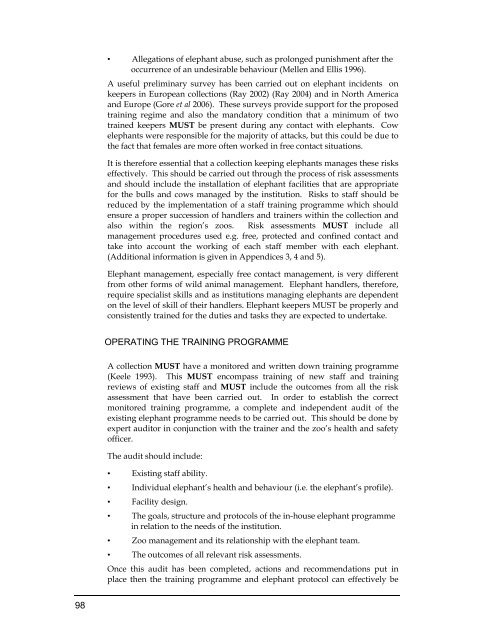Elephants Elephants - Wildpro - Twycross Zoo
Elephants Elephants - Wildpro - Twycross Zoo
Elephants Elephants - Wildpro - Twycross Zoo
You also want an ePaper? Increase the reach of your titles
YUMPU automatically turns print PDFs into web optimized ePapers that Google loves.
98<br />
• Allegations of elephant abuse, such as prolonged punishment after the<br />
occurrence of an undesirable behaviour (Mellen and Ellis 1996).<br />
A useful preliminary survey has been carried out on elephant incidents on<br />
keepers in European collections (Ray 2002) (Ray 2004) and in North America<br />
and Europe (Gore et al 2006). These surveys provide support for the proposed<br />
training regime and also the mandatory condition that a minimum of two<br />
trained keepers MUST be present during any contact with elephants. Cow<br />
elephants were responsible for the majority of attacks, but this could be due to<br />
the fact that females are more often worked in free contact situations.<br />
It is therefore essential that a collection keeping elephants manages these risks<br />
effectively. This should be carried out through the process of risk assessments<br />
and should include the installation of elephant facilities that are appropriate<br />
for the bulls and cows managed by the institution. Risks to staff should be<br />
reduced by the implementation of a staff training programme which should<br />
ensure a proper succession of handlers and trainers within the collection and<br />
also within the region’s zoos. Risk assessments MUST include all<br />
management procedures used e.g. free, protected and confined contact and<br />
take into account the working of each staff member with each elephant.<br />
(Additional information is given in Appendices 3, 4 and 5).<br />
Elephant management, especially free contact management, is very different<br />
from other forms of wild animal management. Elephant handlers, therefore,<br />
require specialist skills and as institutions managing elephants are dependent<br />
on the level of skill of their handlers. Elephant keepers MUST be properly and<br />
consistently trained for the duties and tasks they are expected to undertake.<br />
OPERATING THE TRAINING PROGRAMME<br />
A collection MUST have a monitored and written down training programme<br />
(Keele 1993). This MUST encompass training of new staff and training<br />
reviews of existing staff and MUST include the outcomes from all the risk<br />
assessment that have been carried out. In order to establish the correct<br />
monitored training programme, a complete and independent audit of the<br />
existing elephant programme needs to be carried out. This should be done by<br />
expert auditor in conjunction with the trainer and the zoo’s health and safety<br />
officer.<br />
The audit should include:<br />
• Existing staff ability.<br />
• Individual elephant’s health and behaviour (i.e. the elephant’s profile).<br />
• Facility design.<br />
• The goals, structure and protocols of the in-house elephant programme<br />
in relation to the needs of the institution.<br />
• <strong>Zoo</strong> management and its relationship with the elephant team.<br />
• The outcomes of all relevant risk assessments.<br />
Once this audit has been completed, actions and recommendations put in<br />
place then the training programme and elephant protocol can effectively be

















